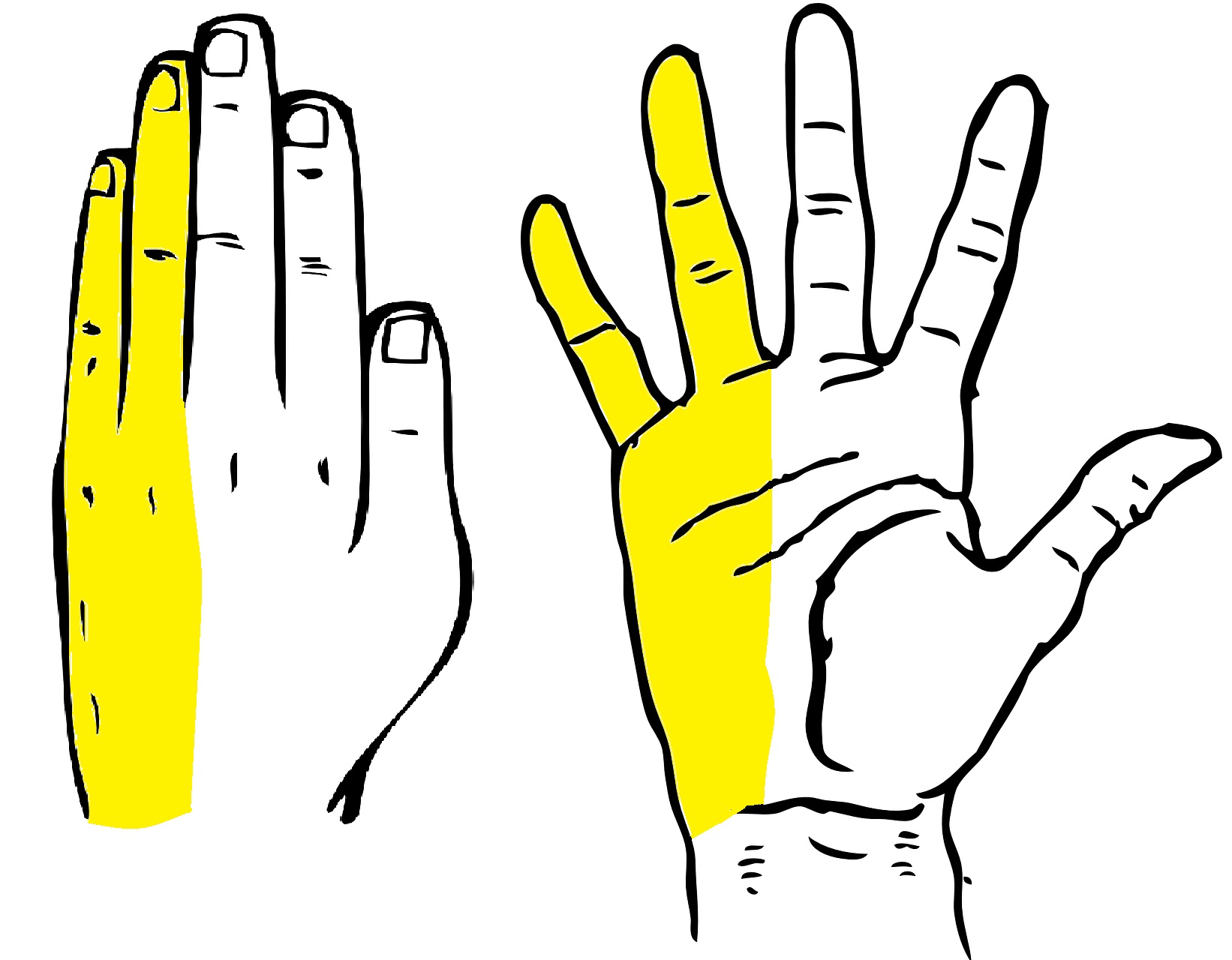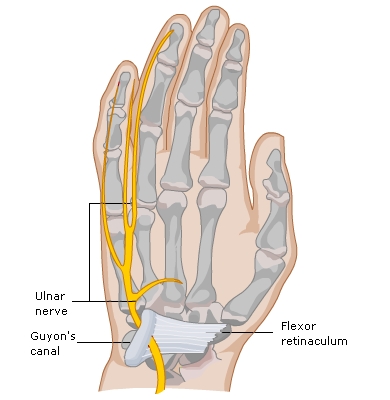Cyclist's palsy: Difference between revisions
Evan Thomas (talk | contribs) mNo edit summary |
Evan Thomas (talk | contribs) mNo edit summary |
||
| Line 6: | Line 6: | ||
== Description<ref name="Glo">Gloria,C. Cohen, MD, CCFP. Cycling Injuries. Canadian Family Physician, VOL 39, March 1993</ref> == | == Description<ref name="Glo">Gloria,C. Cohen, MD, CCFP. Cycling Injuries. Canadian Family Physician, VOL 39, March 1993</ref> == | ||
Cyclist’s palsy, | Cyclist’s palsy, also known as ulnar neuropathy or "handlebar palsy", is a familiar affection of the long-distance cyclist. Typically, the ulnar nerve becomes irritated because of the pressure exerted by the hands on the handlebars, particularly when riding on rough terrain. As people cycle, they often have their wrist resting in a hyperextended position on the handlebars or hoods which compresses and stretches the ulnar nerve as it passes from wrist to hand. The symptoms are numbness, tingling, and possibly motor limitation along the course of the ulnar nerve. More often, the superficial sensory branch of the ulnar nerve is affected as opposed to the deep motor branch. Symptoms of [[Ulnar Nerve Entrapment|ulnar neuropathy]] can take weeks or months to subside.<br> | ||
[[Image:Cyclists palsy ulnar involvement.jpg|center]] | |||
[[Image:Cyclists palsy ulnar involvement.jpg|center]] | |||
== Clinically Relevant Anatomy<ref name="Bick">Bickerton, T. Handlebar Palsy. Where to ride. [ONLINE] accessed on 24 september 2010. Available at http://www.wheretoridelondon.co.uk/London-262.html</ref> == | == Clinically Relevant Anatomy<ref name="Bick">Bickerton, T. Handlebar Palsy. Where to ride. [ONLINE] accessed on 24 september 2010. Available at http://www.wheretoridelondon.co.uk/London-262.html</ref> == | ||
Revision as of 19:03, 13 May 2016
Original Editor - Arno De Maeyer
Top Contributors - Lucinda hampton, Wanda van Niekerk, Evan Thomas, Kim Jackson, Kenneth de Becker, Vanessa Rhule, Scott Buxton, Arno De Maeyer, Anas Mohamed, Chrysolite Jyothi Kommu, Admin, Laura Ritchie, Wendy Walker, Naomi O'Reilly and Claire Knott
Description[1][edit | edit source]
Cyclist’s palsy, also known as ulnar neuropathy or "handlebar palsy", is a familiar affection of the long-distance cyclist. Typically, the ulnar nerve becomes irritated because of the pressure exerted by the hands on the handlebars, particularly when riding on rough terrain. As people cycle, they often have their wrist resting in a hyperextended position on the handlebars or hoods which compresses and stretches the ulnar nerve as it passes from wrist to hand. The symptoms are numbness, tingling, and possibly motor limitation along the course of the ulnar nerve. More often, the superficial sensory branch of the ulnar nerve is affected as opposed to the deep motor branch. Symptoms of ulnar neuropathy can take weeks or months to subside.
Clinically Relevant Anatomy[2][edit | edit source]
The ulnar nerve is a branch of the brachial plexus that comes out at the neck, between the scalene muscles. Then the nerve transverses the length of the arm and crosses over the elbow after which it divides into its respective terminal branches. The nerve gives off two sensory branches which supply sensation to parts of the back of the hand and the little finger and half off the ring finger. At the wrist, the ulnar nerve enters the hand by passing through Guyon’s Canal. This is the tight tunnel that is formed between the os hamatum and the os pisiform and the pisohamate ligament which keeps the two bones together. Either within or just beyond the tight tunnel, the ulnar nerve divides again in two motor branches.
The most common area of compressive damage of the ulnar nerve in the cyclist occurs at or just before the Guyon’s Canal. This is the place where the ulnar nerve splits in two[3].
Epidemiology/Etiology[2][edit | edit source]
Cyclist Palsy develops itself during cycling. The position of the hands while holding the handlebars gives pressure on the ulnar nerve in the canal. The pressure of holding the handlebar in combination with vibrations from the road or trails is enough to damage the nerve. This causes the neuropraxia. Especially when we are driving downhill, a large part of the body weight is supported by the hand on the corner of the handlebar. This leads to a high load at Guyon’s canal. Because no sensory fibers are affected, the patients are not aware of the fact that there’s a compression of the ulnar nerve until a severe lesion develops.
The hyperextended position of the hands on the handlebars also helps cause the neuropathy by compressing and stretching the nerve as it passes from wrist to hand[1].
Characteristics/symptoms[1][edit | edit source]
The symptoms may vary from person to person, but they are always similar. Possible symptoms are weakness, numbness, tingling, and possibly motor limitation along the course of the ulnar nerve.
Often the patients complain about numbness or tingling in the hand that goes away within a day or two, but then they have persistent weakness with pinching and fine finger movements.
Differential diagnosis[2][edit | edit source]
It is important to know the signs and symptoms of this ailment so that it can be easily identified and a proper diagnosis established without having to go for numerous tests. We have to check if the patient is able to effectuate an adduction of the thumb, this could be the result of paralysis of the M. adductor pollicis.
Paralysis of the mm. interossei is also possible, than there is no abduction and adduction possible for all the fingers. To check this, the patient lays his hand on the table and the therapist asks him to lift his third finger up. The patient is asked to do an adduction and an abduction with this finger pertaining to the fourth finger. This is not possible if the patient suffers from cyclist’s palsy, in that case we see as compensation a shift from the flat of the hand and the wrist goes to the ulnar side.
People who have cyclist’s palsy in an advanced stadium could have a claw hand. Surgery is sometimes performed when we are already at that stage.
Diagnostic Procedures[edit | edit source]
After the diagnosis of the physiotherapist we perform an additional research like ultrasound, CT-scan and NMR. This is to trace the exact place of the compression.
Prevention[1][edit | edit source]
Prevention is the most important part to avoid cyclist palsy, and it can be effectively prevented. More in particular, cushioning the pressure points by using padded handlebars and padded cycling gloves is effective. This provides an extra layer of fat tissue inside the palm, so that there is a better shock absorption and protection from pressure. Also the position of the hands on the handlebar is important. Individual adaption of the handlebar and riding position is crucial for prevention of this ailment[4]. The cyclist should regularly change the hand position on bars.
Enthusiastic long-distance cyclists should also adopt a comfortable and resilient riding posture. Because if the trunk gets tired, the hands will invariably bear more weight to stabilize them on their bike. Developing a better posture on the bike requires strong trunk muscle endurance[3].
Treatment[edit | edit source]
This type of nerve injury is self-limiting. So the nerve will regenerate on its own and function of the muscles will be restored. But the symptoms of handlebar palsy can take weeks or months to heal. While the nerve and muscles are regenerating, the patient needs to interrupt his sport activities for a while. A traditional treatment can help the healing. Prevention is important for this type of neuropraxia (see prevention). Also make sure that the cyclist rides on the right size of bicycle and check the position of the handlebars.
References[edit | edit source]
- ↑ 1.0 1.1 1.2 1.3 Gloria,C. Cohen, MD, CCFP. Cycling Injuries. Canadian Family Physician, VOL 39, March 1993
- ↑ 2.0 2.1 2.2 Bickerton, T. Handlebar Palsy. Where to ride. [ONLINE] accessed on 24 september 2010. Available at http://www.wheretoridelondon.co.uk/London-262.html
- ↑ 3.0 3.1 Praktijkgids Pols-en handletsels. Meeusen, R. p. 74-77
- ↑ Capitani, D. and Beer, S. Handlebar palsy-a compression syndrome of the deep terminal (motor) branch of the ulnar nerve in biking. Journal of Neurology. 7 May 2002, pag. 1441-1445
- ↑ Specialized Bicycles. Specialized Body Geometry Gloves Available from: https://www.youtube.com/watch?v=EYlU6TBAhlg [last accessed 7/2//2016]








